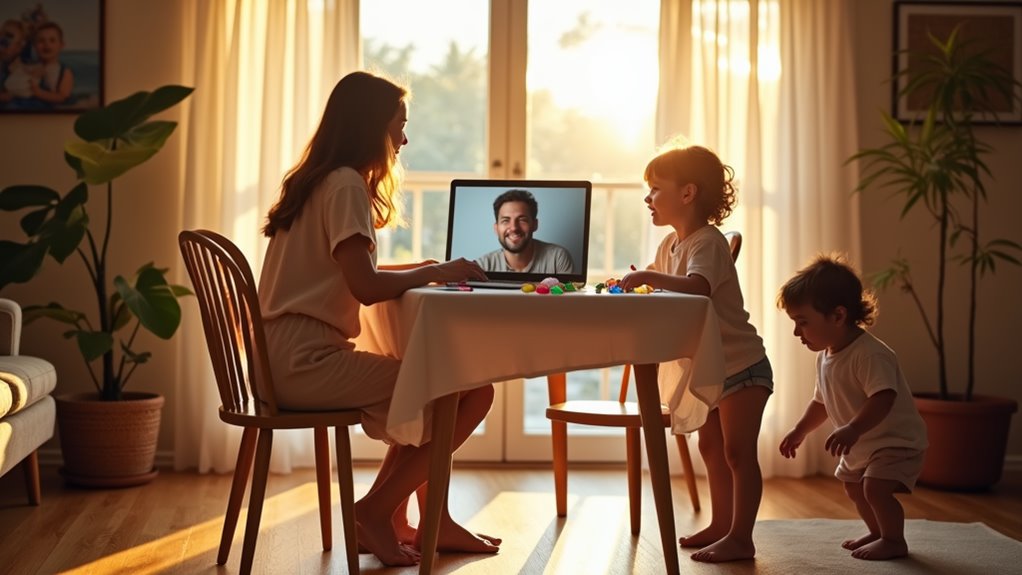Understanding online safety for children is super important to keep them safe in our digital world. You'll want to teach them about keeping personal information private, just like not sharing secrets with strangers. Be on the lookout for digital dangers like cyberbullying and phishing, which can ruin their fun. Setting up parental controls can help you monitor online activity, too, ensuring they stick to age-appropriate content. Open conversations about online behavior foster trust and boost their critical thinking skills. By exploring these topics, you'll help them navigate the web safely while having a blast—there's so much more to discover!
Importance of Online Safety
As kids increasingly engage with the internet, understanding online safety becomes essential for their well-being. You might think the internet is all fun and games, but it can also be a tricky place. That's why you need to know how to stay safe while exploring.
Just like you'd wear a helmet while riding a bike, online safety helps protect you from potential bumps and bruises in the digital world.
First, it's important to keep your personal information private. Sharing details like your address or phone number can lead to trouble. Think of it this way—would you invite a stranger into your home? Probably not! Likewise, don't share too much online.
Also, be careful about the friends you make in the digital space. Some may not be who they seem. It's like that time you thought a vegetable was a fruit—looks can be deceiving!
Lastly, always talk to a trusted adult if something feels off. They can help you navigate any tricky situations.
Common Digital Threats
Several common digital threats can lurk online, and knowing about them is key to staying safe.
One big threat is cyberbullying, where someone uses the internet to hurt or embarrass another person. It's like being picked on at school, but it can follow you home, too.
Then there's phishing, where someone pretends to be a trusted friend or company to steal your information. Imagine someone fishing in a pond, but instead of fish, they're reeling in your passwords!
You also need to watch out for malware, which are sneaky programs that can harm your device or steal your data. Just like how you wouldn't open a strange package at your door, don't click on mysterious links or download unknown apps.
Finally, there's online predators who might try to befriend you online but don't have good intentions. They can be as tricky as a fox in a henhouse!
Setting Up Parental Controls
One effective way to protect your child online is by setting up parental controls on their devices. These controls act like a digital superhero, helping you monitor what your child sees and does online.
You can start by checking the settings on their devices—most smartphones, tablets, and computers come with built-in parental controls. It's like having a safety net!
You can block certain websites, limit screen time, and even filter content to make sure it's age-appropriate. If your child loves watching videos, platforms like YouTube offer specific settings to restrict content. It's super easy to navigate once you get the hang of it.
Don't forget about apps! Many apps have their own settings to help you manage what your child can access. You can also explore third-party apps designed specifically for parental control.
Just remember, you're not trying to invade their privacy; you want to keep them safe and sound.
Setting these controls might take a little time, but think of it as a fun project. You're building a safer online world for your child, and that's definitely worth it!
Teaching Responsible Internet Use
How can you guarantee your child navigates the online world responsibly? Start by having open conversations about the internet. Explain that while it's a fantastic place for fun and learning, it also has some not-so-friendly corners.
Encourage your child to think critically about what they see online, like asking questions about sources or spotting fake news.
Make sure they understand the importance of privacy, too. Teach them never to share personal information, like their address or school name, with strangers. You wouldn't hand your house keys to someone you just met, right?
Set clear guidelines for internet use, including when and how long they can browse. Consistency is key!
Also, use real-life examples, like discussing a movie or a game that touches on online behavior. This helps them see the relevance in everyday life.
Lastly, model good behavior yourself. Show them how you practice responsible internet use. Your actions speak louder than words!
Monitoring Online Activity
While teaching responsible internet use lays a strong foundation, keeping an eye on your child's online activity is equally important. You wouldn't let your kid run around a busy street without supervision, right? The same goes for the digital world. Start by setting clear rules about what's acceptable online. This helps your child understand boundaries and stay safe.
You can use parental control apps or built-in device features to help monitor their activity. These tools let you see what sites they visit and how much time they spend online. But remember, it's not just about spying! You want to be a guide, not a ghost. Encourage your child to talk about what they're doing online. This way, you can keep an eye on things while building trust.
Also, keep devices in shared spaces like the living room. This makes it easier to check in and have casual conversations about their online experiences.
If you notice something concerning, approach it calmly and thoughtfully. After all, it's about keeping them safe and helping them navigate the internet confidently. So, step in, but don't hover—let them learn while you keep an eye out!
Encouraging Open Communication
Many parents find that fostering open communication about online experiences is essential for their child's safety. When kids feel comfortable talking about their online activities, they're more likely to share any concerns or weird encounters they might have.
So, how can you encourage this kind of communication?
Start by creating a relaxed atmosphere at home. Make it clear that talking about the internet is as normal as discussing school or friends. You could even share your own funny or awkward online moments—kids love to hear that adults mess up, too!
Ask open-ended questions like, "What's the coolest thing you saw online today?" or "Have you met anyone interesting while gaming?" This way, you're not just drilling them with questions; you're inviting them to share.
Always listen attentively and avoid reacting too strongly. If they mention something troubling, stay calm. This will help them feel safe and understood.
Resources for Parents
As a parent, having access to reliable resources can make a significant difference in your child's online safety. You don't have to navigate this digital world alone. There are plenty of websites and organizations designed to help you understand the ins and outs of online safety.
For starters, check out Common Sense Media. They offer reviews on apps, games, and movies, plus tips for keeping kids safe online.
You might also want to look at the Family Online Safety Institute. They provide guides on everything from social media to gaming, helping you set up those all-important parental controls.
And don't forget about your local library! Many libraries hold workshops on internet safety, which can be a goldmine of information.
Lastly, remember that talking about online safety doesn't have to be all doom and gloom. Use these resources to spark fun conversations with your kids.
Maybe even turn it into a game! You can quiz them on online safety facts or role-play different scenarios.
With these tools in your toolkit, you'll feel more confident in helping your child navigate the online world safely and smartly.
Building Digital Resilience
Equipping your child with the skills to handle online challenges is just as important as providing resources for safety. Digital resilience means your child can bounce back from online mistakes or tough situations.
Start by encouraging open conversations about their online experiences. Ask them about their favorite games or apps, and share your own funny stories about tech mishaps. This builds trust and makes them feel safe to talk about anything weird or uncomfortable they encounter.
Teach them to think critically about what they see online. Remind them that not everything on the internet is true, and sometimes things can be exaggerated or even fake. Encourage them to question what they see and hear.
Also, help your child set boundaries. It's okay for them to take breaks from screens or even block someone who's bothering them. Talk about how to spot online bullying and the importance of reporting it.
Finally, celebrate their successes! When they handle a tricky situation well, let them know you're proud.
Building digital resilience isn't just about surviving the internet; it's about thriving in it, and with your support, they can do just that!





